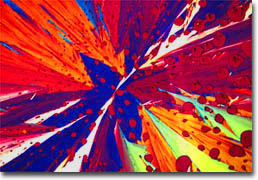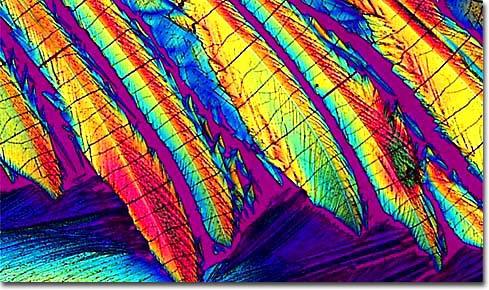|
All organisms must deal with a wide spectrum of different environments and be able to react to various factors such as danger, stress, and other organisms in order to survive. In bacteria, for instance, a major concern is determining the origin of a food supply. This problem is usually handled via the chemotactic response mechanism, which enables bacteria to sense and swim toward food sources and away from noxious conditions. Multicellular organisms, however, have evolved a more complex system that responds to external stimuli through the use of specialized sense organs and the communication of the information from these sensors to other parts of the organism. This type of communication falls into two categories. The first category is the transmission of chemical messengers between one tissue and another. The second is a more multifarious mechanism that involves the generation and transmission of impulses through the central nervous system.

Dopamine
In higher organisms, the chief unit of the central nervous system is a highly specialized cell termed a neuron, which serves to transmit impulses. In the human brain there are approximately 10 billion neurons, each with its own identity and function. The communication processes carried out among such a large body of cells is complex and the basic cellular structure for neurons differs radically from that of different types of cells. Most neurons have a cell body somewhat like that found in other somatic cells, however, they also exhibit a variety of projections (or processes) called dendrites and axons. Dendrites are branched protoplasmic extensions that receive neural signals from adjacent cells and conduct them inwards toward the body of the neuron. A single neuron may feature multiple dendrites. Typically, however, neurons each only possess a single long, threadlike axon, which carries signals away from the cell body and is capable of transmitting them to a dendrite on an adjacent cell. The connection between the axon terminals of one cell and the dendrites of an adjacent cell is called a synapse. The transmission of signals across a synapse is initiated by the presence of an electrical impulse and is accomplished by the use of small chemical messengers that are termed neurotransmitters.

Serotonin
A considerable number of chemical substances are believed to act as neurotransmitters, but the identification of only a few have been widely accepted. Among these, the earliest to be discovered was acetylcholine, which was first broadly recognized as a neurotransmitter in the 1920s largely due to the work of Austrian researcher Otto Loewi, who produced direct evidence of a sympathetic neurotransmitter by stimulating the autonomic nerves of a frog heart, resulting in the release of a chemical that decreased the beat rate of a second heart suffused with fluids from the other organ. Loewi's achievement was largely inspired by the earlier efforts of British physiologist Henry Dale, and a number of other scientists are also believed to have contributed significantly towards the modern understanding of neurotransmitters. Gaining knowledge about neurotransmitters has been a relatively slow, difficult process, however. Many of the early concepts regarding the chemicals have since been proven wrong. For instance, Dale purported that a neurotransmitter released at one axon terminal of a neuron was also released at other axon terminals of the same cell, though subsequent studies suggest that this is not necessarily the case. Nevertheless, over time a serviceable amount of knowledge about neurotransmitters has been accumulated, some of the most heavily researched of the chemicals being serotonin, dopamine, epinephrine, and norepinephrine.

Acetylcholine
The increasing availability of information about neurotransmitters in the latter half of the twentieth century resulted in massive changes in the medical and pharmaceutical fields. Indeed, conditions such as amyotrophic lateral sclerosis, also known as Lou Gehrig's disease, and Parkinson's disease, a degenerative brain disorder originally described by British doctor James Parkinson in 1817, came to be understood in new ways. Found to be associated with decreased levels of dopamine in the brain, Parkinson's became the first disease for which a neurotransmitter-based treatment was utilized. Today, drugs that contain metabolic precursors of dopamine, which can be converted into the neurotransmitter once within the body, continue to be used as an effective way to decrease symptoms of the disease and slow their onset, but do not provide a cure, suggesting that other unknown factors are the real cause of Parkinson's. Mood disorders are another good example of a kind of condition that has come to be widely treated with drugs that affect neurotransmitter release and function. Indeed, as early as the 1950s, depression began being attributed to deficiencies in certain neurotransmitters, and an array of pharmaceuticals that could help correct this problem soon appeared on the market.

Norepinephrine
The majority of early anti-depressant drugs produced were not designed to affect specific neurotransmitters, but rather had an influence on many or all of them. A variety of pharmaceuticals known as Monoamine Oxidase Inhibitors (MAOI), for example, function by inhibiting the activity of oxidases, substances that are able to break down neurotransmitters in the brain. The idea behind treatment with the drug is that as a result of its action, increased levels of neurotransmitters build up in the central nervous system and help individuals come out of a depressed state. While MAOI drugs are still available, they can cause severe side effects in some cases and have become significantly less popular as pharmaceuticals with activity restricted to influencing only certain neurotransmitters have been developed. The most prominent of this new variety of anti-depressants is the drug known as Prozac, which is Specific Serotonin Re-uptake Inhibitor (SSRI) that functions in a way that results in the prolonged presence of serotonin in the synapses of the brain. Avid Carlson, a Swedish scientist, was responsible for making many of the advances that resulted in the eventual development of Prozac, which became one of the top-selling drugs worldwide by the mid-1990s.
|




